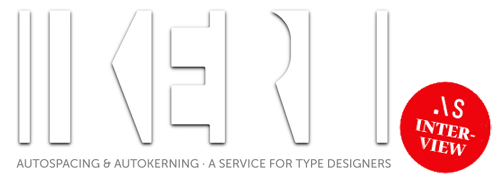ikern
Der Italiener Igino Marini bietet mit »iKern« einen Autospacing- and Autokerning-Service für Schriften an, der so manchem Schriftdesigner das Leben erleichtern kann. Bei iKern geht es nicht nur ums Kerning – wie man vom Namen her vermuten könnte – sondern um das Erzeugen von Spacing (Zeichenabständen) und Kerning (Unterschneiden). Der Prozess des Autospacing begann erst nachdem der Name iKern bereits gefunden war; der aus fünf Buchstaben bestehende Name und die Domain blieben jedoch.
Igino Marini hat uns ein paar Fragen beantwortet:
Why do you offer metrics data generation only as a service but not as a tool or programme?
Ikern is mainly a mathematical model that describes an interaction between shapes. Then is a software that uses this model. I would say that the software is just a necessary side effect of the model development. Giving away the software would mean to give away the model. And I'm not comfortable with this. Not yet. What's more Ikern is a very general model. It can achieve excellent results when well tuned, when the right choices are done. But it can also produce terrible output not knowing how to handle it. Not only I still wanted to be responsible of it. But over the time I felt that doing type metrics is a separate task from type design that requires a specific competence. Or at least I've been pushed to feel it from type designers requests of keep reworking their fonts!
Do you have a lot of requests? For which fonts did you already do the metrics this way?
I'm having a costantly growing number of requests. I think it's natural: the more the fonts, the more the testimonies, the less the diffidence. The fact is that for years I had to convince type designers: using an automated solution is still seen as something that reduces the perceived value of the product. That's why I renounced to publish on my site notices about fonts. Many designers didn't want to be cited at all, many wanted but not about specific jobs. So I've decided to use the same measure for all: those who want can leave their one time testimony comment on a “What They Say” page on my site [ http://ikern.com/k1/collaboration/ ]. I think the wide range of the presented designers and styles begins to give an idea of the quality and versatility of the service. I also think the competition among type foundries is increasing and working structures are generally lightening so a service like mine can really cut times and general expenses.
Isn't spacing and kerning normally a part of the fontdesign so that the fontdesigner could do it by himself?
This is a double question. About metrics definition being part of font design I would say that it's obvious that a type designer have to have in mind the spacing when designing. But the final fitting, that has to achieve an optimum overall compromise between rhythm, consistency and glyph separation, it's all a different game. It's a specific task that has to deal with functionality and not with expression. It's true that what is optimum for me couldn't be optimum for the type designer. That's why a feedback process is always present. About the possibility for a type designer to do the metrics I would say that more than a possibility it's historically a necessity. The more evident the less the foundries are big. Big foundries always had this kind of “silent” specialized people. And once type designers had to even cut their glyphs!
What is your professional background? Why have you specialized on fonts?
I'm an engineer. Specializing on fonts just started as a hobby when digitizing the Fell Types. But when I began to investigate about spacing and kerning I immediately discovered the absolute absence of a working math model behind. That's why I had to begin. By the way to handle fonts is a complex task because of font formats. So for interfacing and to produce results I had to learn how to handle them and write specific codes.
Why do you offer the service for free?
Usually mine is a paid service but sometimes I see young type designers with good ideas struggling in production difficulties. I'm glad to give an help. Or better I prefere to actually doing something instead of giving benevolent advises.
What are the recent developments behind the programme iKern? On your website you say that you are still developing on it?
The development is always on a double path. Database and data management in general have to be improved to be more as possible fast, efficient and, why not, error-free. Expecially with fonts growing in size more and more. The model is still evolving. As always. Actually I'm not having new ideas to put inside but I'm literally discovering the potentiality of the already present ideas. To be explicit on this would seem at least geeky, I think. I can only say that I procede giving the same importance to the experiment and to the elegance of the formulation. When I read the main algorhythm (a nearly 10.000 lines of code single routine that outputs both sidebearing and kerning values) I don't think that it's powerful. I think that it's beautiful. And when elegance and results procede together one can only be happy.
Thank you for the interview.

